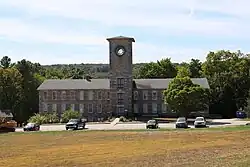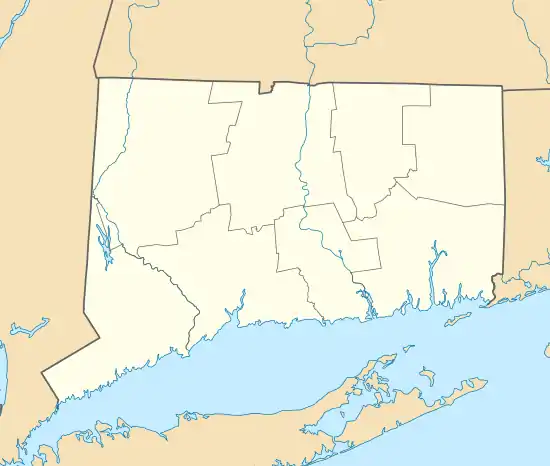Mansfield Hollow Historic District
The Mansfield Hollow Historic District encompasses the remnants of a modest 19th-century industrial village on Mansfield Hollow Road in Mansfield, Connecticut. Originally industrialized with saw and grist mills, a silk mill was added in 1838, when its most significant growth began. The surviving stone mill was built in 1882, and there are a number of nearby houses dating to the industrial period. The district was listed on the National Register of Historic Places in 1979.[1]
Mansfield Hollow Historic District | |
 Kirby's Mill | |
  | |
| Location | 86-127 Mansfield Hollow Rd., Mansfield, Connecticut |
|---|---|
| Coordinates | 41°45′25″N 72°11′9″W |
| Area | 18 acres (7.3 ha) |
| Built | 1800 |
| Architect | Fitch, Edwin; Multiple |
| Architectural style | Greek Revival |
| NRHP reference No. | 79002667[1] |
| Added to NRHP | May 21, 1979 |
Description and history
The central Connecticut town of Mansfield, now best known as the home of the University of Connecticut at Storrs, supported a number of small industrial villages in the 19th century. Mansfield Hollow, located south of Mansfield Center, is one of the places where industry flourished, on the north bank of the Natchaug River, now a short way west of Mansfield Hollow State Park. This area's industrial history began in the 18th century, when Barzillai Swift acquired a water privilege, and established saw and grist mills. His sons George and Fearing continued the business, and also leased part of the privilege to Oliver Bingham. The houses of all three of these men survive in the area today. In 1838 Zalman Storrs established a silk mill, which marked the beginning of textile development and the construction of housing for workers. The silk mill ran for a number of years under several owners, until 1882, when Marcus Johnson built the surviving stone mill for finishing cotton thread. In 1902 it was sold to George Kirby (for whom it is now colloquially known as "Kirby's Mill"), who manufactured brass items until after World War II.[2]
The district extends mainly along Mansfield Hollow Road and Mansfield Hollow Road Extension, and its visual focus is the 1882 stone mill, with its prominent 75-foot (23 m) tower.[2] The district also includes a collection of residential buildings (between 86 and 127 Mansfield Hollow Road), most which are historically significant. Notable among them are the Fearing Swift House, 103 Mansfield Hollow Road, built in 1815, the George Swift House, 100 Mansfield Hollow Road, built in 1804, and the Oliver Bingham House, 88 Mansfield Hollow Road, probably the oldest house in the district (built 1800).[2]
References
- "National Register Information System". National Register of Historic Places. National Park Service. March 13, 2009.
- Bruce Clouette (November 16, 1978). "National Register of Historic Places Inventory-Nomination: Mansfield Hollow Historic District". National Park Service. and Accompanying 10 photos, exterior and interior, from 1976 and 1978 (see photo map page 13 of text document)